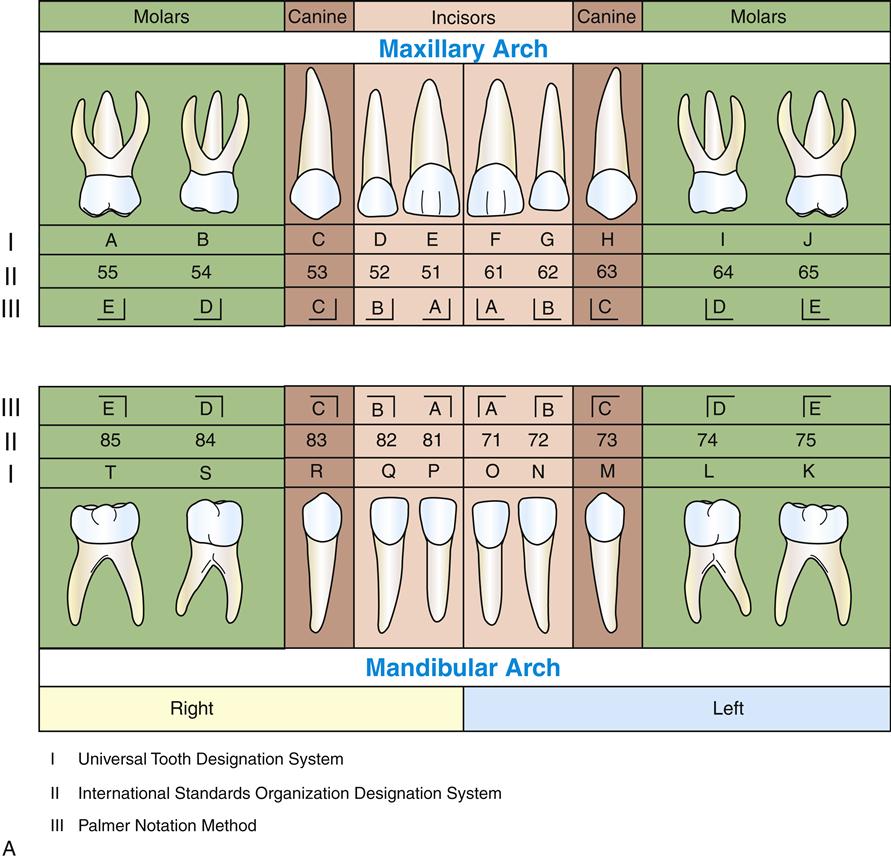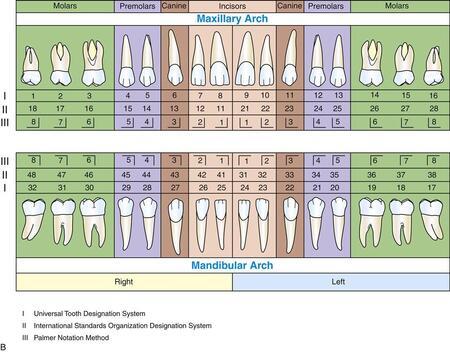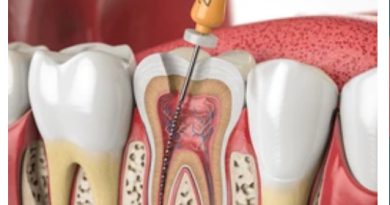Tooth Numbering Systems
There is a total of 32 teeth in the adult mouth and 20 teeth in the mouth of a child. With so many teeth, dental professionals needed a way to be able to associate information with each tooth. For example, is there decay present on a tooth? Is the tooth cracked, broken, worn, or infected? If so, which tooth?
Zsigmondy-Palmer Notation System
The first tooth notation system, (first tooth numbering system), was introduced in 1861 by a Hungarian dentist named Adolf Zsigmondy and was referred to as the Zsigmondy system. The idea was to use a Zsigmondy cross +, also referred to as chevron or set square system, to record quadrants, (upper left, lower left, upper right, and lower right), and the position of the tooth in each quadrant. The numbers 1-8 were used to designate the adult teeth and Roman numerals were used to identify primary (baby teeth, deciduous teeth, milk teeth), teeth.
In 1891, a Danish dentist by the name of Victor Haderup revised the eight tooth quadrant system for adult teeth by replacing the symbols ┘└ ┐┌ used to identify the quadrants with plus (+) and minus (-) to not only distinguish between quadrants but upper and lower tooth placement as well. For example, an upper left central incisor would be notated as +1 and the lower right central incisor would be notated as 1-. The primary teeth used the plus (+) and minus (-) symbols, but instead of letters, the teeth were assigned numbers 01 – 05.
The Zsigmondy system later became known as the Zsigmondy-Palmer or Palmer notation when Dr. Corydon Palmer (a 19th- century dentist from Ohio) changed the Roman numerals used for identifying primary teeth to letters A-E and used symbols (┘└ ┐┌ )to identify the quadrants for both the primary and adult teeth. Under these new changes, the adult teeth would have the same number but would be designated by a symbol to denote which quadrant the tooth was located. For example, the maxillary (upper) right central incisor would be notated as 1⏌. The mandibular (lower) left central incisor would be notated as ⎾1 . This system is primarily used in the United Kingdom
Universal Tooth Numbering System
In 1882, a German dentist named Julius Parreidt created a tooth numbering system for primary and adult teeth. The primary teeth were assigned the letters A-T, while the adult teeth were assigned the numbers 1-32.
This system does not divide the mouth into quadrants to assign letters or numbers to the teeth. Instead, the assignment of letters, (for the primary teeth), and numbers, (for the adult teeth), are consecutive across the whole maxillary (upper) arch and mandibular (lower) arch. For the primary teeth, the letter “A” is given to the maxillary right 2nd molar, “B” is given to the maxillary right first molar, “C” is assigned to the canine, and, so on, ending with the letter “J” assigned to the upper left first molar. The letter “K” is assigned to the lower-left 2nd molar, the letter “L” for the lower-left 1st molar, and, so on, ending with the letter “T” assigned to a lower right second molar.
The adult teeth follow the same pattern, beginning with the number “1” assigned to the upper right 3rd molar (wisdom tooth), the number “2” assigned to the upper right 2nd molar, ending with the number “16” assigned to the upper left 3rd molar. The numbering continues with the lower (mandibular) arch with the number “17” assigned to the lower-left 3rd molar, ending with the number “32” assigned to the lower right 3rd molar.
Because this numbering system follows a sequential pattern and is easy to understand and use, the American Dental Association, accepted the Universal Numbering system in 1968. This system is primarily used by dental professionals in the United States and Mexico.
FDI Notation System or ISO 3950 Notation System
The FDI (Fédération Dentaire Internationale )World Dental Federation was founded in Paris in 1900 and is based in Geneva Switzerland. This non-governmental organization is the world’s leading dental organization representing more than one million dentists worldwide. Included in its membership are over 200 specialist groups and national member associations spanning over 130 countries.
The FDI system is a two-digit tooth numbering system widely used internationally by dentists and the World Health Organization (WHO) to accurately associate information to an individual tooth. Similar to the Palmer notation system, the mouth is divided into four distinct quadrants. For both the adult teeth and the primary teeth, the first number in the 2-digit numbering system designates which quadrant the tooth is located. The quadrants are as follows;
Adult Teeth
#1 – Upper Right Quadrant
#2 – Upper Left Quadrant
#3 – Lower Left Quadrant
#4 – Lower right Quadrant
Primary Teeth
#5 – Upper Right Quadrant
#6 – Upper Left Quadrant
#7 – Lower Left Quadrant
#8 – Lower Right Quadrant
The second number in the 2-digit number system designates the tooth position from the midline (center) of the arch. The numbers 1-8 are used for the adult teeth and numbers 1-5 are used for the primary teeth.
For example, an upper right second molar would be defined as the number 17. The #1 defines the quadrant (upper right), and the #7 defines the position of the tooth from the center of the arch. (The central incisor is tooth #1. Tooth #2 is the lateral incisor. Tooth #3 is the canine. Followed by tooth numbers 4 and 5 for the first and second premolars and number 6 for the first molar.)
A lower left canine would be assigned the number 33. The first #3, identifies the quadrant. The second number 3, identifies the tooth location from the midline. (The first tooth is the central incisor. The second tooth is the lateral incisor and the third tooth is the canine.)
The primary teeth follow the same pattern, with the first number designating which quadrant the tooth is located in and the second number identifying the location of the tooth from the midline.
For example, the lower right lateral incisor would be assigned the number “82”. The number “8” defines the quadrant and the number “2”, defines the location of the tooth. The first tooth would be the central incisor. The second tooth would be the lateral incisor. 


